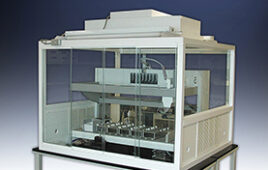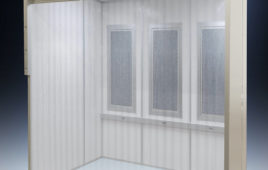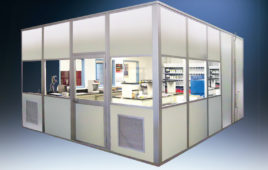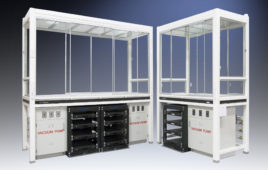“I have to let off steam, Barbara. Let’s talk” said Kevina.
Kevina was driving home from a cleanroom training session. Barbara really needed a break from the report she was writing. So, devoting part of a crisp, morning in Southern California and a cool evening in Ireland, they discussed some of the challenges facing our cleanrooms today with regard to cosmetics such as tattooed makeup, fake tans, and long, fake, gel nails. After lengthy discussions they came up with a few suggestions and ideas that perhaps may be worth a thought.
TATTOOED MAKEUP
Most cleanroom protocols state ‘No makeup allowed’. So imagine the fashion gurus concocting the idea of ‘glamour in the cleanroom without contamination’ the “ideal” solution—permanent makeup! Surely there should be no problem with a cleanroom employee arriving at work on Monday morning sporting tattooed eyeliner and lipstick.
Well, there is a problem. Other employees start to arrive at work in the cleanroom sporting eyeliner and lipstick that may not be tattooed, permanent makeup. So now the problem arises as to how we prove who is or is not wearing permanent makeup. Suddenly the standard cleanroom protocol of ‘No makeup allowed’ is non-existent. In some instances, the employee has requested a document from the tattoo artist certifying that the makeup was tattooed; this was kept in their file. This was the only escape route to avoid a finding of “non-conformance to procedure” during audits.
One approach to avoiding controversy regarding tattoos, natural beauty, and makeup would be to require everyone to wash their hands and faces before entering the cleanroom. Of course, as Kevina pointed out, there is the issue of contamination due to skin flakes from dry skin. Moisturized skin is preferable to dry skin. One solution might be to require everyone to wash their faces and then apply a cleanroom approved, non silicone moisturizer. Doctors have specified “scrub” procedures prior to performing surgery. One would think that employees should have specified decontamination procedures before they enter cleanrooms, particularly where products impacting public safety and patient safety are being produced.
FAKE TANS
What about fake tans? Employees might assert that obtaining a fake tan does not constitute makeup. Analysing the components of every type of fake tan and their impact on the specific product manufactured would be costly, and an overall policy banning fake tans may be difficult to enforce. However, the appearance of an orange “ring-around-the-collar” would seem to be a tell tale sign that body makeup is in use. Asking all employees to shower prior to entering the cleanroom might be an extreme measure. However, it would be reasonable to update rules regarding cleanroom protocol to reflect the most recent beautification technologies. It would also be useful to provide employees with the understanding and awareness as to why makeup is banned in the cleanroom and to clearly state that body makeup including artificial tanning lotions are included.
FAKE NAILS
Another common policy includes the banning of long, fake, artificial or gel nails as well as nail polish in the cleanroom, and hopefully everybody knows why. Fake nails have been detected in finished packaged product by experienced vigilant inspectors. Kevina indicates that these instances have been reported around the time of Christmas parties. This is an area where firming up the protocols is essential. Saying that long nails or fake nails “SHOULD” be avoided is the sort of statement that can result in product recalls, that endangers public safety and that endangers lives.
BREAKDOWN IN COMPLIANCE
The overall breakdown in compliance with the above cleanroom protocol is exacerbated by a “double-tiered” policy. That is, some companies allow visitors to wear makeup on the grounds that they will not be assembling product. In our opinion this is not a good enough justification. Whether a visitor, auditor, external person, or internal person who does not enter the cleanroom regularly and is not familiar with the cleanroom protocols, all should abide by the same set of rules. Allowing different cleanroom rules and policies for visitors or external people creates a caste system that is counterproductive.
Barbara has a different opinion about protocol for very occasional cleanroom observers. She feels there will always be occasional exceptions and that approaches to exemptions should be developed. Consider a scenario where the president of a small biotech company arrives with a potential investor. The investor wants to inspect the cleanroom. The investor is wearing shell pink fingernails with tiny hand-painted flowers. In such an instance, Barbara would suggest explaining the cleanroom rules carefully. If the investor insists on inspecting the cleanroom, it should be required that this visitor wear gloves, be prohibited from touching product and be required to stand a respectful distance from any fabrication, cleaning, or assembly operation. At the same time, it is more than reasonable to communicate cleanroom requirements and to require compliance by those involved in cleanroom activities. This includes consultants, motivational speakers, safety/environmental professionals, facilities people, repair personnel, and visiting dignitaries.
PROACTIVE INVOLVEMENT WITHIN THE CLEANROOM
When asked about the most important factor in manufacturing, many employees put people ahead of production. It is important that our priorities are right on this one. The most important factor in our cleanrooms is the end product and ensuring that the end product is safe and of the highest quality possible consistently and reproducibly for the end user. Breaches in cleanroom protocol must not be allowed to result in an unsafe product. At the same time, skilled, educated cleanroom employees are essential for production of quality product.
It would be productive to have greater proactive involvement within a company and to provide an unambiguous message to employees. In general practice, Human Resources people seem to be independent of cleanroom operations. HR may bow to pressures from technicians and assemblers and perhaps may also respond to company policies to foster employee independence. HR may even prohibit policies set forth by Quality Assurance. Kevina trains personnel working in cleanrooms facilities regarding cleanroom protocol to reduce contamination risks. She trains people from all levels, from directors to operators. However she cannot recall ever having an HR person sit in on her training courses. Barbara cannot recall any HR involvement, either.
Perhaps HR could be made part of the solution to reconciling employee self-esteem with requirements for contamination control. In larger companies, perhaps a HR cleanroom liaison could be appointed. This person would participate in the training/education required of new and existing employees. It would be very reasonable to require HR people to invest some time in observing actual cleanroom practices and to explain the importance of those practices.
Other groups besides HR could benefit from engaging in the cleanroom experience. In our two previous columns, we discussed superfluous design and activity in the cleanroom. Engineers have been known to specify unnecessary, illogical, and redundant procedures and requirements, sometimes under the general guise of “cleanroom discipline”. Where such procedures are unnecessarily, invasive, or even downright unachievable, cleanroom operators will either defy/ignore the rules outright or develop creative interpretations of those rules. Requiring engineers writing the protocol and process flow to spend an entire shift in the cleanroom actually practicing what they preach could be an excellent investment in moving toward higher reliable product, rugged processes, saving money, and achieving enforceable cleanroom personnel practices.
Dr. Kevina O’Donoghue is a microbiologist at Micro Matters, Galway, Ireland. She has worked with cleanrooms for nearly 10 years. She developed and delivers a internationally accredited training program on “contamination control practices within the clean room environment” and is one of the founders and facilitators of a clean room technology network group. Contact her at [email protected].
Barbara Kanegsberg and Ed Kanegsberg, Ph.D. “The Cleaning Lady” and “The Rocket Scientist,” are independent consultants in surface quality including critical/precision cleaning, contamination control, and validation. They are editors of “The Handbook for Critical Cleaning,” CRC Press; an updated two-volume second edition. Contact BFK Solutions LLC, 310-459-3614; [email protected].




